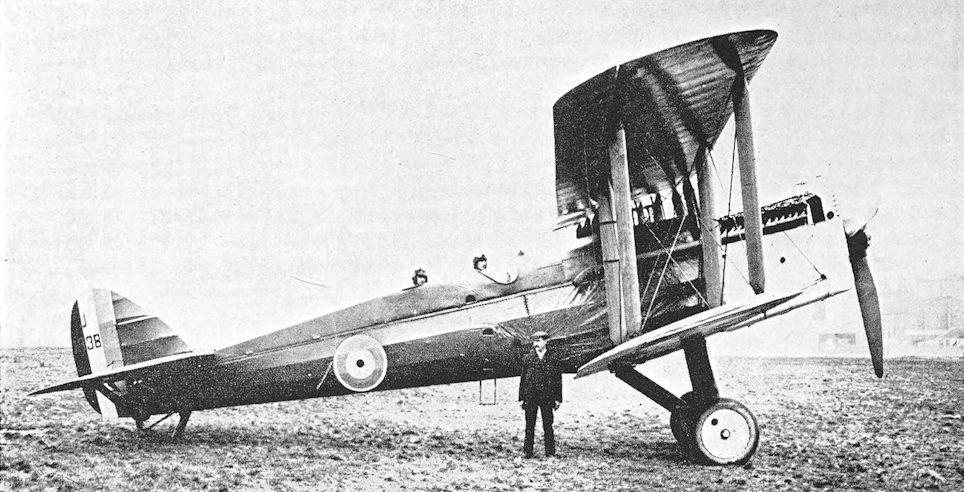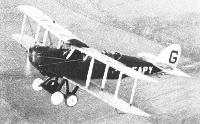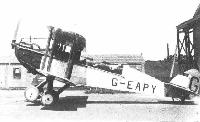A.Jackson De Havilland Aircraft since 1909 (Putnam)
De Havilland D.H.14 Okapi
The D.H.14 was an extremely large single engined, two seat biplane of conventional appearance designed in 1918 as a replacement for the D.H.4, D.H.9 and D.H.9A. Its performance and military potential were such that had the war lasted, Berlin would have suffered considerable damage at the hands of D.H.14 crews. Although too late for the war, the D.H.14 contract was not cancelled but construction was considerably delayed and in accordance with the system of aircraft nomenclature laid down in Technical Department Instruction No. 538, it was given the type name Okapi.
Since 1917 the Rolls-Royce company had been developing a 12 cylinder Vee-type watercooled engine similar to, but larger than, the Eagle. Fitted with four instead of two valves per cylinder, it gave 525 h.p. and was named the Condor. The D.H.14 was one of the first aircraft fitted with this engine which was cooled by a large nose radiator with controllable shutters.
Although externally similar to a D.H.9A and structurally orthodox, the design included several novel features and many detail differences. Fuel tanks of 178 gallons capacity were housed in the fuselage aft of a fireproof engine bulkhead and fuel starvation experienced at low air speeds when using wind driven pumps was eliminated by using gravity feed. The unusual depth of the fuselage made it possible to blank off the upper portion of the main tank as a gravity tank and to rely on wind driven pumps only in cruising flight. The pilot’s synchronised Vickers gun was sited in a deep groove in the top decking, heavy gauge steel tubing was used for the engine mounting, strengthening blocks of aluminium were inserted in the lower longerons at undercarriage attachment points and the bomb load was stowed internally. Six 112 lb. bombs were carried inside the lower wing between the spars and two in the fuselage under the pilot's seat, draughts being prevented by covering the bomb openings with brown paper. Bombs were released manually by the gunner whose cockpit was fitted with twin Lewis guns on a Scarff mounting. Risk of shooting away his own tailplane bracing was eliminated by suppressing the top wires in favour of four faired tubular struts underneath, the rear pair of which were hinged to the bottom of the tail trimming tube and controlled tailplane incidence. This somewhat vulnerable gear, first fitted to the D.H.11, was protected by an additional curved member aft of the main tail skid. The undercarriage consisted of the usual wooden Vee struts and was sprung by rubber cord wound round the axle.
Three airframes were laid down but rigid postwar economies sounded the death knell of the D.H.14 and resulted in longevity for the D.H.9A. The first two aircraft, J1938 and J1939, were well advanced by July 1919 but the third airframe was finished first - completed by Airco as the private venture D.H.14A for the Daily Mail transatlantic flight competition with Napier Lion and fuel capacity increased to 586 gallons. When the arrival in Ireland of Alcock and Brown ended the project, the D.H.14A stood in the Hendon works until first flown in the autumn of 1919 as F. S. Cotton’s entry for the Australian Government England-Australia flight competition.
Ross and Keith Smith reached Darwin in their Vickers Vimy, G-EAOU, before Cotton was ready but Maj. Gen. Sefton Brancker, a director of Airco, then loaned him the aircraft for a flight to Cape Town. Registered G-EAPY and crewed by Cotton and Napier engineer W. A. Townsend, it left Hendon on February 4, 1920, immediately forced landed at Cricklewood with oil trouble but eventually reached Rome on February 21. Despite two additional wheels fitted forward of the main undercarriage, it turned over while landing on a beach 18 miles north east of Messina, Italy, on February 23 after failing to find the aerodrome.
G-EAPY was shipped back from Naples, rebuilt by Airco with three cockpits and sold to Cotton for the Aerial Derby of July 24, 1920. On the last leg of the race a petrol leak started a fire and the aircraft was badly damaged when it struck telephone cables in a forced landing near Hertford. The engine was salvaged and fitted to the Westland Limousine III. G-EARV, which Cotton took to Newfoundland later that year.
When Airco closed down, the unfinished military D.H.14s were completed at Stag Lane by the de Havilland Aircraft Co. Ltd. J1938, flown in September 1920, went to Farnborough where, on December 22 Sqn. Ldr. Roderic Hill flew it on Condor engine trials. Except for brief visits to Martlesham on March 3 and 17, it spent the whole of 1921 at Farnborough, making occasional test flights which culminated in an endurance test on September 8 and rate of climb trials on November 24. It crashed at Burnham Beeches, Bucks. on February 10, 1922 while returning from Chingford, F/O Robinson and observer Mitchell being killed.
After Cotton’s aircraft was repaired at Stag Lane it emerged as J1940 and records show that test pilot H. ‘Jerry’ Shaw, with W. K. Mackenzie as observer, made unsticking trials there on March 13, 1921 at all-up weights between 6,400 lb. and 6,820 lb., the shortest take-off in a 12 knot wind being a mere 215 yards.
The second military machine, J1939, was delivered to Martlesham on April 14,1921 but the D. H. 14 remained on the Secret List and was not seen in public until one, probably J1939, was flown from Martlesham to Croydon by A. H. Orlebar for the Imperial Air Conference display of February 3-6, 1922.
SPECIFICATION AND DATA
Manufacturers:
The Aircraft Manufacturing Co. Ltd., Hendon, London, N.W.9
Completed by the de Havilland Aircraft Co. Ltd., Stag Lane Aerodrome, Edgware, Middlesex
Power Plants:
(D.H.14) One 525 h.p. Rolls-Royce Condor I
(D.H.14A) One 450 h.p. Napier Lion
Dimensions:
Span 50 ft. 5 in.
Length
(D.H.14) 33 ft. 111 in.
(D.H.14A) 37 ft. 7 in.
Height 14 ft. 0 in.
Wing area 617 sq. ft.
Weights:
(D.H.14) Tare weight 4,484 lb. All-up weight 7,074 lb.
(D.H.14A) Tare weight 4,006 lb.
Performance:
(D.H.14)
Maximum speed at 10,000 ft. 122 m.p.h.
Rate of climb at 10,000 ft. 400 ft./min.
(D.H.14A)
Maximum speed 117 m.p.h.
Production:
(D.H.14)
J1938 c/n E.44, crashed at Burnham Beeches 10.2.22
J1939 c/n E.45, delivered to Martlesham 14.4.21
(D.H.14A)
J1940/G-EAPY c/n E.46, registered to Airco 4.12.19, re-registered to F. S. Cotton 20.5.20, damaged at Hertford 24.7.20; repaired and flown as J1940; delivered to Air Ministry 16.4.21
Показать полностью
F.Manson British Bomber Since 1914 (Putnam)
Airco D.H.14 Okapi
Conceived as a successor to the Airco D.H.4, D.H.9 and D.H.9A, before the last-named had entered widespread service, the D.H.14 was ordered in prototype form a fortnight before the Armistice was signed when a far-reaching appraisal of the RAF’s peacetime aircraft requirements was hurriedly conducted. The document produced (now in Public Record Office AIR/1/2423, dated 25 November 1918) lists the D.H.14 as being considered as future equipment and a possible replacement for the D.H.10 Amiens day bomber under the Air Ministry Technical Department’s Specification VIII. In fact the manufacturer was at that time working to an amended version of Specification IVA, which had been superseded.
The apparent confusion arose because the likely performance of the D.H.14, particularly in range and bomb load, was not far short of that being demanded of the prototypes already ordered for competitive evaluation to become a potential D.H.10 replacement, a fact that had not escaped the Air Ministry’s notice. Being powered by a single engine and with a two-man crew, it was likely that the unit cost of the D.H.14 would be significantly less than the twin-engine contenders. This consideration would become progressively more significant as the postwar cost-cutting began to take effect on the Services.
The D.H.14, named the Okapi, was a large aeroplane for a single-engine aircraft, its size being dictated by the big 600hp, 21.4-litre Rolls-Royce Condor engine selected, and the bomb and fuel loads envisaged. Superficially it was not unlike an enlarged Liberty-powered D.H.9A, the Condor being provided with a large rectangular frontal radiator. Construction of the three prototypes was of wood throughout, the bomb load of six 112 lb bombs being accommodated in the fuselage in two bays between the wing spars and beneath the pilot's cockpit.
Work on the Condor engine slowed down after the Armistice, and the first military D.H.14, J1938, was not flown until September 1920 at Stag Lane, having been taken over and completed by the new de Havilland Aircraft Company after the demise of Airco. (The third D.H.14, J1940, had been completed a year earlier and, as G-EAPY on the Civil Register, was powered by a 450hp Napier Lion engine. Flown by F S Cotton and W A Townsend in an attempt to fly to South Africa, it crashed in Italy on 4 February 1920. Repaired, and carrying its military serial, J1940, it was delivered to Martlesham Heath for comparative trials with the other, Condor-powered D.H.14 prototypes in April 1921.)
The Okapi J1938 paid its first visit to Martlesham in December 1920, the month in which the second Okapi was first flown. Both aircraft underwent a long series of flight trials, much of their time being spent contributing to the development of the Condor engine, expected to become one of the RAF's cornerstone powerplants in a few years' time. The initial version, the Mark I, although intended to produce 600hp, was derated for the Okapi trials at 525hp, until J1939 was fitted with a fully-rated Condor IA in November 1921. Both prototypes were written off early in 1922, J1938 hitting a tree and being destroyed by fire on 10 February, while J1939 was damaged beyond economic repair in an accident during April.
Type: Single-engine, two-seat, two-bay biplane medium bomber.
Air Ministry Specifications: D of R Type 4A (as amended); later RAF Type IX.
Manufacturer: The Aircraft Manufacturing Co Ltd, Hendon, London NVV9.
Powerplant: One 525hp Rolls-Royce Condor I (later IA) V-twelve, water-cooled, in-line engine driving four-blade propeller. D.H.14A. 450hp Napier Lion.
Dimensions: Span, 50ft 5in; length, 33ft 11 1/2 in (D.H.14A, 37ft 7in); height, 14ft 0in; wing area, 617 sq ft.
Weights: Tare, 4,484 lb; all-up (six 112 lb bombs and full fuel), 7,074 lb.
Performance (Condor I): Max speed, 126 mph at sea level, 122 mph at 10,000ft; endurance, 5 hr.
Armament: Provision to carry six 112 lb bombs internally. Gun armament comprised one fixed, synchronized, 0.303in Vickers machine gun firing forward, and one Lewis gun with Scarff ring on observer's cockpit.
Prototypes: Two D.H. 14s, J1938 (first flight, 29 or 30 September 1920) and J1939; J1940 (D.H.14A) first flown as G-EAPY on 4 December 1919. No production.
Показать полностью
P.Lewis British Bomber since 1914 (Putnam)
At the tail end of Airco’s exemplary wartime performance in construction of production and prototype aircraft to Geoffrey de Havilland’s designs, there came two final biplane bombers. The two-seat D.H.14 Okapi day bomber, of which three prototypes were ordered, was in the process of being designed before the Armistice was declared, but construction was carried on at a slower rate after the end of 1918. The intention was that the new machine should take over from its predecessors from Airco, the D.H.4, D.H.9 and D.H.9A, which it resembled, but on a larger scale.
The Okapi was given two-bay wings of equal span, set with moderate positive stagger and was designed around the Condor I, a powerful new water-cooled, twelve-cylinder vee engine from Rolls-Royce which developed 525 h.p. The nose incorporated a frontal radiator, and the engine drove a four-blade propeller; the necessary ground clearance for the blades made a relatively lengthy undercarriage mandatory. The crew were seated in adjacent tandem cockpits mid-way along the fuselage. Both were armed - the pilot with a Constantinesco-synchronized Vickers set in the coaming and the observer with a pair of Scarff-mounted Lewis guns. Eight 112 lb. bombs formed the Okapi’s load, being carried internally by storing six inside the lower wings and two in the fuselage beneath the pilot.
Reduction, immediately post-war, of interest in developing new bombers curtailed the rate of completion of Okapis J1938 and J1939, but J1940 was finished late in 1919 in a modified form as the D.H.14A high-speed, long-range mail-carrier G-EAPY powered by a 450 h.p. Napier Lion. A second pair of wheels was added to the undercarriage ahead of the original main wheels prior to the London-to-Cape Town flight which was attempted by F. S. Cotton and W. A. Townsend, who took-off on 2nd February, 1920. A forced landing in Italy at Alessina resulted in the D.H.14A turning over and, during the subsequent repairs, the extra wheels were discarded.
The two military Okapi prototypes were completed later at Stag Lane by the newly-formed de Havilland Aircraft Company, J1938 in September, 1920, followed by J1939. Official trials were conducted with both machines at Martlesham, whither they went in the spring of 1921, but no further development ensued.
Показать полностью
J.Bruce British Aeroplanes 1914-1918 (Putnam)
de Havilland 14, the Okapi
THIS massive single-engined biplane was designed as a replacement for the D.H.4, D.H.9 and D.H.9A in the day-bomber squadrons. Design work began before the Armistice, but construction was not completed until 1919. In late 1918, the type was officially (and somewhat incongruously) named Airco Okapi.
In appearance the D.H.14 was entirely conventional. It was a straightforward two-seat two-bay biplane with a plain vee undercarriage and the usual de Havilland tail-unit, but it was one of the first aeroplanes to have the then-new Rolls-Royce Condor twelve-cylinder vee engine which delivered no less than 600 h.p. The engine was installed behind a large flat rectangular radiator, and drove a four- bladed airscrew. Internal stowage for the bombs was provided in the capacious fuselage.
The Rolls-Royce company had begun design work on the engine which was named Condor late in
It was generally similar to the Eagle but had four valves per cylinder instead of the Eagle’s two; and, with a displacement of 2,138 cu in., was a much larger engine. The Condor was originally intended to be the power unit for the Handley Page V/1500. The first Condors were not available until early 1919; they developed 600 h.p., but were type-tested at only 525 h.p.
The Armistice prevented the development and production of the D.H.14, but in 1920 a specially modified machine appeared under the type number D.H.14A. This aircraft had a Napier Lion engine of 450 h.p., and an additional pair of wheels were ultimately added to the undercarriage in front of the normal wheels in order to lessen the risk of nosing-over on bad ground. The D.H.14A was intended for use as a high-speed mail-carrier, and in 1920 it began an attempt to fly to South Africa. Unfortunately, it was wrecked in a forced landing in Italy.
SPECIFICATION
Manufacturers: The Aircraft Manufacturing Co., Ltd., Hendon, London, N.W.
Power: 600 h.p. Rolls-Royce Condor.
Dimensions: Span: 50 ft 5 in. Height: 14 ft. Chord: 6 ft 6 in. Gap: 6 ft 10 in. Dihedral: 3. Span of tail: 15 ft 3 in.
Areas: Wings: 617 sq ft. Ailerons: each 2359 ft, total 92 sq ft. Tailplane: 58 sq ft. Elevators: 31-5 sq ft. Fin:
5-9 sq ft. Rudder: 15-4 sq ft.
Weights: Loaded: 7,074 lb.
Armament: One fixed forward-firing Vickers machine-gun, synchronised by Constantinesco gear, for the pilot; one free Lewis machine-gun on Scarff ring-mounting on rear cockpit for the observer. Four bombs could be carried internally in cells between the spars of the lower wings; two more bombs were carried internally under the pilot’s seat.
Serial Numbers: J.1938-J.1939.
Показать полностью
H.King Armament of British Aircraft (Putnam)
D.H.14 Okapi
Dating from 1918-19 (and still extant in 1922) this high-performance single-engined bomber followed the now-established de Havilland practice of stowing the bombs internally. The bombs were suspended vertically by their noses, four of 112 lb in two double crates between the main spars and two of the same weight in single crates beneath the pilot’s seat. Brown paper was used to cover the openings of the bomb cells in order to exclude draughts. The pilot had a Vickers gun, set deep in a groove in the top decking, and there were twin Lewis guns on the rear Scarff ring-mounting. For these guns six double drums of ammunition were provided. Field of fire benefited from the suppression of the tailplane top-bracing wires in favour of struts beneath.
Показать полностью
A.Jackson British Civil Aircraft since 1919 vol.1 (Putnam)
DE HAVILLAND D.H.14A
Unfinished D.H.14 day-bomber airframe completed by the Aircraft Manufacturing Co. Ltd. at Hendon 1919 as a long-range two-seater with 450-h.p. Napier Lion. One civil aircraft only: G-EAPY, c/n E. 46, left Hendon 4.2.20 fitted with four-wheel undercarriage and piloted by F. S. Cotton and W. A. Townsend on attempted Cape flight. Crashed near Messina, Italy. Shipped home, repaired, damaged in forced landing at Hertford during Aerial Derby 24.7.20, written off 2.21. Span, 50 ft. 5 in. Length, 37 ft. 7 in. Tare wt., 4,006 lb. Max. speed, 117 m.p.h.
Показать полностью








